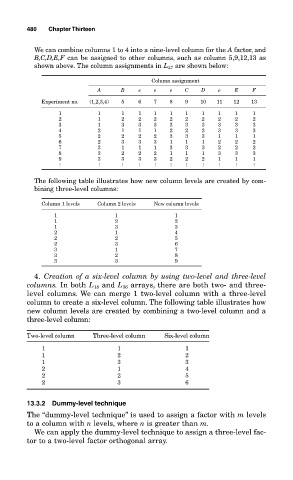Page 521 - Design for Six Sigma a Roadmap for Product Development
P. 521
480 Chapter Thirteen
We can combine columns 1 to 4 into a nine-level column for the A factor, and
B,C,D,E,F can be assigned to other columns, such as column 5,9,12,13 as
shown above. The column assignments in L 27 are shown below:
Column assignment
A B e e e C D e E F
Experiment no. (1,2,3,4) 5 6 7 8 9 10 11 12 13
1 1 1 1 1 1 1 1 1 1 1
2 1 2 2 2 2 2 2 2 2 2
3 1 3 3 3 3 3 3 3 3 3
4 2 1 1 1 2 2 2 3 3 3
5 2 2 2 2 3 3 3 1 1 1
6 2 3 3 3 1 1 1 2 2 2
7 3 1 1 1 3 3 3 2 2 2
8 3 2 2 2 1 1 1 3 3 3
9 3 3 3 3 2 2 2 1 1 1
The following table illustrates how new column levels are created by com-
bining three-level columns:
Column 1 levels Column 2 levels New column levels
1 1 1
1 2 2
1 3 3
2 1 4
2 2 5
2 3 6
3 1 7
3 2 8
3 3 9
4. Creation of a six-level column by using two-level and three-level
columns. In both L 18 and L 36 arrays, there are both two- and three-
level columns. We can merge 1 two-level column with a three-level
column to create a six-level column. The following table illustrates how
new column levels are created by combining a two-level column and a
three-level column:
Two-level column Three-level column Six-level column
1 1 1
1 2 2
1 3 3
2 1 4
2 2 5
2 3 6
13.3.2 Dummy-level technique
The “dummy-level technique” is used to assign a factor with m levels
to a column with n levels, where n is greater than m.
We can apply the dummy-level technique to assign a three-level fac-
tor to a two-level factor orthogonal array.

